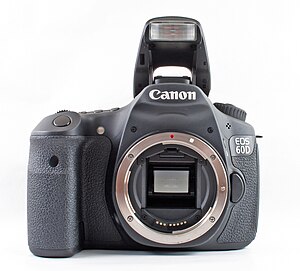Canon EOS 60D
 | |
| Overview | |
|---|---|
| Type | Digital Single-lens reflex |
| Intro price | US$1099.00[1] |
| Lens | |
| Lens | Interchangeable (EF, EF-S) |
| Sensor/medium | |
| Sensor | CMOS APS-C 22.3 × 14.9 mm (1.6x crop factor) |
| Maximum resolution | 5,184 × 3,456[2] (17.9 megapixels) |
| Film speed | 100–6400 (expansion up to 12,800) |
| Storage media | SD, SDHC or SDXC |
| Focusing | |
| Focus modes | One-shot, AI Servo, AI-Focus, Manual |
| Focus areas | 9 cross-type AF points |
| Focus bracketing | none |
| Exposure/metering | |
| Exposure modes | Full auto, programmed, shutter-priority, aperture priority, manual |
| Exposure metering | TTL, full aperture, 63 zones |
| Flash | |
| Flash | pop-up |
| Flash bracketing | none |
| Shutter | |
| Shutter | focal-plane |
| Continuous shooting | up to 5.3 frames/s |
| Viewfinder | |
| Viewfinder | Optical pentaprism / LiveView LCD |
| Image processing | |
| White balance | 7 presets, Auto and custom 2000–10000 Kelvin, 100 K steps |
| General | |
| LCD screen | 3-inch 3:2 color TFT articulated LCD, 1,040,000 dots |
| Battery | LP-E6 |
| Weight | 755 g (1.664 lb) |
| Made in | Japan |
The Canon EOS 60D is a digital single-lens reflex camera from Canon. It was the first Canon EOS camera which had an articulating LCD screen. It was publicly announced on August 26, 2010 with a suggested retail price of US$1099.00.[1] As part of the Canon EOS line of cameras, it succeeded the EOS 50D and preceded the EOS 70D camera.
Apart from its screen, the main new features of the 60D in the two-digit Canon line include increased resolution and ISO range, full-HD video capabilities, and in-camera post-processing functions for the images. It uses the DIGIC 4 image processor.
Like the 50D, the camera has a LCD of settings on the top of the camera where the ISO, AF-Mode, Shooting mode, and metering mode can be controlled.
The 60D is offered for purchase as a body alone or in a package with an EF-S 18-200mm f/3.5-5.6 IS lens, EF-S 17–85 f/4-5.6 IS USM lens, EF-S 18–135 f/3.5-5.6 IS lens or an EF-S 17-55mm f/2.8 IS.
Specification

Compared to the EOS 50D the following changes were made:
- Resolution increase to 18.1 megapixels APS-C CMOS Sensor (50D has 15.1 megapixels).
- Maximum sensitivity increased to ISO 6400 (12800 as optional setting) (50D has max 3200 ISO, with 6400 and 12800 as optional settings).
- Video recording, with same controls as the 550D/Rebel T2i.
- Manual control of audio recording (same as newer firmware on 5D MkII).
- Articulating screen (3.0”) with a slightly higher resolution in 3:2 ratio (50D has 4:3).
- The 60D screen, unlike that of the 50D, matches the aspect ratio of the sensor.
- Lower maximum burst frame rate of 5.3 fps (50D maximum is 6.3 fps).
- SD/SDHC/SDXC card slot (50D uses CompactFlash).
- Smaller and lighter polycarbonate resin with glass fibre on aluminium chassis (50D has magnesium alloy body).
- Wireless Speedlite control.
- Lack of AF micro-adjustment feature (included in 50D).
- Redesign of controls – multi-controller has been relocated to center of quick control dial; top buttons of 60D control only one setting.
- Locking mode dial.
- Electronic level that can be viewed in the viewfinder, rear LCD monitor, and top LCD panel.
- LP-E6 battery, as used in the 5D MkII and 7D.
- Lack of PC socket for flash synchronization.
- External shutter release port changed from 'Canon N3' socket to 3/32" (2.5mm) TRS pin.
- In-camera RAW development and built-in creative filters and special effects.
Digital Photography Review described the changes as representing the move from 'semi-pro'/'prosumer' to 'enthusiast'[3] due to the reduction in some features; however the pentaprism viewfinder and iconic rear control wheel remain, as does the top informational LCD. The slightly smaller body retains the grip of the two-digit Canon line.[4]
-
The articulated display
-
Top view
-
Back view
-
60D with mounted 50mm f/1.8 II
EOS 60Da
Canon announced a modified version of the EOS 60D for astrophotography on April 3, 2012 called the EOS 60Da. The 60Da is the successor to the EOS 20Da. It was expected to cost $1,499.[5] The camera has a modified infrared filter and a low-noise sensor with heightened hydrogen-alpha (H-alpha) sensitivity for improved capture of red hydrogen emission nebulae.[6] The 60Da is three times as sensitive to H-alpha light as the 60D[7] which is said to allow for better images of nebulae.[citation needed]
References
- ^ a b "Canon EOS 60D First Impressions Review". DigitalCameraInfo.com. Retrieved January 11, 2012.
- ^ "EOS 60D Specifications" (PDF). August 26, 2010. Retrieved 201-08-26.
{{cite web}}: Check date values in:|accessdate=(help) - ^ Thursday, August 26, 2010 04:00 GMT (August 26, 2010). "Canon EOS 60D DSLR announced and previewed: Digital Photography Review". Dpreview.com. Retrieved September 12, 2010.
{{cite web}}: CS1 maint: multiple names: authors list (link) CS1 maint: numeric names: authors list (link) - ^ Laing, Gordon (October 2010). "Canon EOS 60D design and controls". CameraLabs.com. Retrieved January 22, 2012.
- ^ "New Canon EOS 60Da DSLR Camera For Astronomy Enthusiasts Captures The True Colors Of The Cosmos". Retrieved April 3, 2012.
- ^ "CanonEOS 60Da astrophotography camera announced". April 3, 2012.
- ^ Dyer, Alan (September 2012). "The 60Da: Canon's Astrophoto DSLR". Sky & Telescope. 124 (3): 38–41. ISSN 0037-6604.
{{cite journal}}:|access-date=requires|url=(help)
External links
 Media related to Canon EOS 60D at Wikimedia Commons
Media related to Canon EOS 60D at Wikimedia Commons- Canon USA 60D Press release
- Canon 60D Review
- DPReview 60D Preview
- DPReview 60D Review
- Deciding on Buying a Canon 60D – Features
- Canon 60D Review – ZTech




